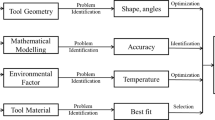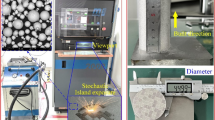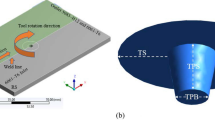Abstract
Light aluminium alloy piston is suitably reinforced at high load-bearing region with cast iron insert, and machining of such bimetallic material is more difficult with a single cutting tool material. Present study focuses on the orthogonal cutting of bimetallic material machining using cubic boron nitride as a cutting tool through finite element analysis. The effects of cutting parameters such as cutting velocity, feed rate and depth of cut on resultant cutting forces and the surface roughness were analysed. Those parameters yielding minimum cutting forces were identified as minimal cutting force parameters, so numerical simulation and experiments were carried out on these parameters. After machining, the intermediate bonding between metallic regions was studied using ultrasonic testing. Bimetallic machining is successfully simulated, and its potential is readily applied to an industrially important component.
Similar content being viewed by others
References
Uthayakumar M, Prabhaharan G, Aravindan S, Sivaprasad JV (2008) Machining studies on bi-metallic pistons with CBN tool using Taguchi method—technical communication. Int J Machining Sci Tech 12:249–255
Grzesik W (2008) Advanced machining processes of metallic materials. Theory of modelling and applications. Elsevier, Amsterdam, The Netherlands
Halil Bil, Engin Kılıç S, Erman Tekkaya A (2004) A comparison of orthogonal cutting data from experiments with three different finite element models. Int J Mach Tool Manuf 44:933–944
Shi J, Liu CR (2004) The influence of material models on finite element simulation of machining. J Manuf Sci Eng 126:849–857
Umbrello D (2008) Finite element simulation of conventional and high speed machining of Ti6Al4V alloy. J Mater Process Technol 196:79–87
Ceretti E, Lazzaroni C, Menegardo L, Alton T (2000) Turning simulation using a three dimensional FEM code. J Mater Process Technol 98:99–103
Uhimann E, von der Schulenburga MG, Zettiera R (2007) Finite element modelling and cutting simulation of Inconel 718. CIRP Ann Manuf Technol 56:61–64
Fang G, Zeng P (2005) Three-dimensional thermo–elastic–plastic coupled FEM simulations for oblique cutting processes. J Mater Process Tech 168:42–48
Venu Gopala Rao G, Mahajan P, Bhatnagar N (2008) Three-dimensional macro-mechanical finite element model for machining of unidirectional-fiber reinforced polymer composites. J Mater Sci Eng Sci Tech 498:142–149
Author information
Authors and Affiliations
Corresponding author
Rights and permissions
About this article
Cite this article
Manikandan, G., Uthayakumar, M. & Aravindan, S. Machining and simulation studies of bimetallic pistons. Int J Adv Manuf Technol 66, 711–720 (2013). https://doi.org/10.1007/s00170-012-4359-x
Received:
Accepted:
Published:
Issue Date:
DOI: https://doi.org/10.1007/s00170-012-4359-x




